|
Introduction
The story of 'Sporus' is so extra-ordinary that some historians consider that
it's fictional. But there are so many contemporary or near
contemporary sources describing the events that denying that Sporus
existed and was a eunuch creates far more problems than it solves. One
challenge with having so many sources is that they are often contradictory - e.g.,
Sporus may have been born a slave, a son of a freeman or even an
illegitimate child of a member of the the imperial family - all hugely different. For the purposes of brevity, I have generally adopted what seems to be the
consensus view, but with the liberty of adopting a minority view or even
speculating slightly myself when this seemed to better fit the overall
story.
This page is not intended to be a scholarly article
that can withstand robust academic challenge, but rather a readable and
reasonably accurate interpretation of an extraordinary story. It is
clearly confusing to have two people with the same name, "Poppaea Sabina",
so when I use just "Poppaea" I'm usually referring to Nero's second
wife, whilst just "Sabina" means his fourth, aka Sporus.

Various images of Emperor Nero (38-67 AD), including a modern facial reconstruction. |
The Beginning
Nero was born in AD 38 by the sister of Emperor Claudius, who adopted him as a
son. Nero then married Claudius' daughter (his stepsister), Claudia
Octavia, when he turned 16. This was a marriage of convenience as she always
bored him. But it cemented
Nero's position as the next emperor - which is exactly what occurred a few
months later after the poisoning and death of Claudius in October AD 54.
When the young Nero became Emperor he was initially very popular with both the
army and population - but this would this slowly change to hate over his 14-year
reign.
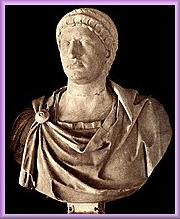
A bust of Marcus Otho (3-69 AD) |
In
AD 58 Nero encountered a renowned Roman beauty, Poppaea Sabina
(AD 30-65).
Poppaea was a very
ambitious woman who had recently divorced her first husband,
Rufrius Crispinus. Rufus had
once been the leader of the
Praetorian Guard
but had since fallen out imperial favour (as Poppaea was undoubtedly aware),
and would eventually be executed by Nero in AD66. They had had one
child together - a boy whom Nero would also
later have killed, drowned in a "fishing accident".
Poppaea quickly re-married, choosing
Marcus Salvius Otho,
whose most attractive attribute was that he was a close friend of
the Emperor. Unfortunately for Otho, he bragged about the beauty of
his new wife to Nero, thus bringing her to his
attention.
Poppaea was soon regularly enjoying the emperor's intimate company.
Nero solved
the problem of an inconvenient cuckold husband by dispatching Otho to become Governor
of the distant province Lusitania - modern day Portugal - in AD69. Poppaea did not
accompany him and they were soon officially divorced,
Otho was probably given no choice but to reluctantly consent to this. Poppaea was now
Nero's official mistress, with the ultimate prize of becoming Empress
within her reach.
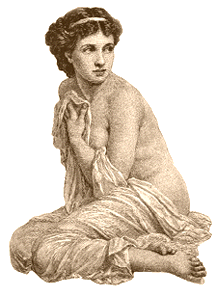 Poppaea was a vigorous and strongly willed woman, and her relationship with
Nero proved to be tempestuous. However Poppaea
also worked hard to keep Nero interested in her. She was very aware that her success with men and in particular
Nero depended heavily on her
exceptional looks, but she was
eight years older than Nero and passing 30 (middle age at time when a good life span
for even a Roman noble was 50-60 years).
She went to great lengths to maintain her appearance, most notably by
copying the Egyptian Queen Cleopatra (who had a similar challenge of
maintaining her attractiveness to Roman Generals when in her 30's) by
bathing in ass milk to stave off winkles and maintain her perfect alabaster-white skin. Her mastery of cosmetics resulted in a style termed “Poppaean.” Her
obsession with her physical appearance was so great that after looking in the
mirror one day, she reportedly prayed for death before her beauty faded - a
wish which would be granted. Poppaea was a vigorous and strongly willed woman, and her relationship with
Nero proved to be tempestuous. However Poppaea
also worked hard to keep Nero interested in her. She was very aware that her success with men and in particular
Nero depended heavily on her
exceptional looks, but she was
eight years older than Nero and passing 30 (middle age at time when a good life span
for even a Roman noble was 50-60 years).
She went to great lengths to maintain her appearance, most notably by
copying the Egyptian Queen Cleopatra (who had a similar challenge of
maintaining her attractiveness to Roman Generals when in her 30's) by
bathing in ass milk to stave off winkles and maintain her perfect alabaster-white skin. Her mastery of cosmetics resulted in a style termed “Poppaean.” Her
obsession with her physical appearance was so great that after looking in the
mirror one day, she reportedly prayed for death before her beauty faded - a
wish which would be granted.

This statue
from c.100 AD - known as the 'Bathing Venus' - is believed to be based upon an old statue of
Poppaea Sabina. But there are hints that it may improbably
be based on Sporus - breast development is unusually limited, the
fingers are typically male, and the left hand is hiding the vulva
area - a rare instance of modesty when depicting male or female
genitalia acceptable. |
Very unusually for a Roman matron, Poppaea was natural red head - a
colour which was stigmatised as being associated with barbarians.
However, when Nero wrote and recited a poem about her amber hair, many Roman women took to
dying their hair with henna in an attempt to emulate Poppaea's tresses.
In May, AD62,
Poppaea was able to tell Nero that she was
pregnant with his child. She now refused to continue just being his
mistress and he resolved the situation by divorcing Claudia Octavia -
an unhappy marriage at best - on the grounds that she was 'barren'.
Just 12 days later Nero and Poppaea married. Nero had however underestimated the popularity of
the staid and modest Octavia among the Roman population, and there were riots demanding her restoration. He barely survived the
situation by fabricating evidence of
Octavia's adultery and banishing her to the small island of
Pandateria, where she was brutally executed and beheaded on 9 June.
 A Roman coin from AD 63 showing the images of both Nero and Poppaea. A Roman coin from AD 63 showing the images of both Nero and Poppaea. |
Poppaea gave Nero a daughter, Claudia,
on 21 January AD 63. Whilst
disappointed by the lack of a son, Nero nevertheless proclaimed his wife
as Augusta (Empress). Sadly, the baby died just four months
after birth, however Poppaea had already consolidated her position as Empress to the extent
that coins bearing her image were being minted and circulated - a rare honour.
In early AD 65 Poppaea became pregnant again, to the delight of Nero.
Unfortunately, this would again not work out well. One night during that summer Nero
returned late and probably drunk from the circus (Chariot races). An
argument ensued with the angry Poppaea, and in a fit of rage Nero
kicked the pregnant woman in the stomach. She died a few days later
from the resulting internal injuries and pregnancy complications.
Whilst bewailing Nero's wickedness, contemporary sources don't doubt his
passion and even love for his dead wife. He was distraught at causing
his wife's death
and went into deep mourning. Poppaea was given
divine honours and a state funeral - a year's worth of Arabia's incense production
was supposedly burnt at her
funeral.
Nevertheless, the reality was that Nero still badly needed a son and heir.
In early AD 66 he unexpectedly chose Statilia Messalina as his next wife -
forcing her husband (with whom she had importantly born a son - proving her
fertility) to commit suicide so that he could marry her.
Statilia was a pleasant but docile wife who would always keep a low profile,
the opposite of Poppaea!
Cassius Dio tells us:
"Nero missed her so greatly after her death that on learning of a woman who resembled her he at first sent for her and kept her; but later he caused a boy of the freedmen, whom he used to call Sporus, to be castrated, since he, too, resembled Sabina, and he used him in every way like a wife."
Sporus was handed over to Calvia Crispinilla, Nero's mistress of the wardrobe, who took care of the boy and was responsible for turning him into an Empress.
"He actually wore his hair parted, young women attended him whenever he went for a walk, he wore women's clothes and was forced to do everything else a woman does in the same way."
The Middle
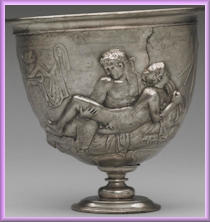
Sporus was
probably a young male sex slave - such as shown on the 'Warren Cup' made
about AD 15. |
Regardless of his latest (and so far unfruitful) marriage to Statilia, it seems that Nero desperately missed
Poppaea.
In late 66AD Nero departed on a famous (or notorious)
15-month long visit to Greece, where he tried (unsuccessfully)
to become a renowned artist, actor and athlete.
At some point in early AD 67 he encountered a teenage boy
(perhaps 15 or 16 years old) who had an extra-ordinary facial resemblance to his former wife,
and with the advantage that he was about 20 years younger than Poppaea was at her
death.
Sporus' birthplace and origins are unclear, but the academic
consensus is that the boy was
a puer delicatus or deliciae (meaning sweet, dainty) - a young sex slave who
due to his exceptional beauty had been drawn to the attention of the emperor
by some courtier.
Assuming that like Poppaea he was very white skinned and red-haired then
he was unlikely to have been Greek, and could even have been born outside
the Empire, e.g. a Celt from Ireland who was purchased by Roman slave
traders.
The boy's true name we will also probably never know, contemporary authors always
call him "Sporus", which seems to be an ironical nickname as it can be
translated as "seed". The female version of the name, "Spora", is
never used in any source.

A Roman
castration clamp dating to the second century AD that was recovered from
the Thames River in London. |
Nero suggested that the boy be castrated - which of course was effectively
an order. It's possible that Sporus was "just" deprived of functioning testes by a method such as
crushing them - which
would have made him a spada. However ancient
sources refer to him as being a castrati,
which is associated with the far more drastic procedure of the surgical
removal of the testes,
scrotum and sometimes even the penis.
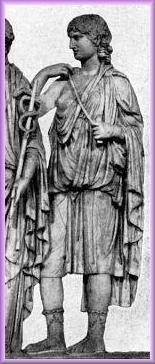
Modest but
visible breast
development in young castrati
was common but not certain. |
Sporus survived the very dangerous (no anti-biotics) and extremely painful
(no strong anaesthetics) castration procedure.
After healing and
pubic hair growth, the external appearance of his bottom may have approximated that of a woman. However, he was too old for
the
castration to have much effect on his skeleton, e.g. height, build,
size of hands and feet. He/she was thus probably above average in
height and size for a woman. Nevertheless, the castration of young Sporus
would have:
-
Stopped his voice from breaking (unless it already had)
-
Prevented an
'Adam's Apple' developing
(unless it already had)
-
Encouraged luxuriant head hair
-
Prevented facial hair growth
-
Resulted in a female type body hair pattern
-
Reduced his musculature
-
Encouraged female type fat deposits
-
Resulted in possible breast growth (gynecomastia)
Greek and Roman illustrations and statues show young spada and castrati with
small breasts, and it's
quite likely that Sporus had some breast growth after being
castrated.
Modern medical studies have found that an
orchiectomy (castration) as a young teenager results in noticeable breast
development in about 50% of cases. Suggestions in modern books that Sporus and other Roman eunuchs
were
given plant-based potions that included 'estrogenic precursors' to help maintain
a youthful appearance and feminise their body are no
more than speculation, and these were unlikely to have had any significant
physical effect
anyway. Theoretically the Romans could even have used the ovaries of female
horses (mares) and other animals as a source of oestrogen to aid physical
feminisation, but there is
no evidence that they did this.
Nero declared that the castrated Sporus was now a woman, renamed her Poppaea Sabina
and took her as his bride.
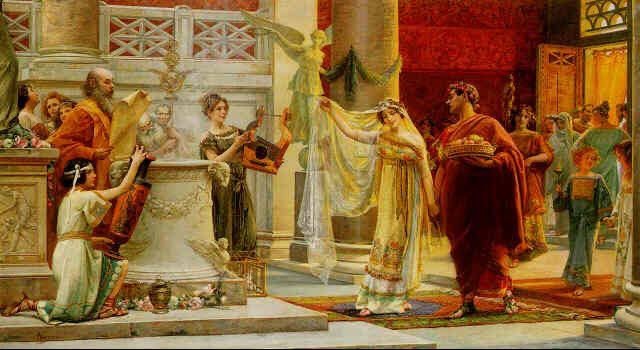
A 19th century painting by Emilio Vasarri vaguely entitled "The Roman Wedding".
When offered for sale in 1997, it was suggested that it depicted Nero marrying
Sporus.The wedding was held in Athens, Greece, probably in June AD 67. The
wedding
was not a quiet event, but a full imperial wedding with
traditional ceremony. Little information about what this involved has
survived, but we do know that Sporus was given a dowry,
wore a bridal veil, and that there was a large
wedding party afterwards -
attended by Senators and members of noble families. Cassius Dio says:
"All the Greeks held a celebration in honour of their marriage, uttering
all the customary good wishes, even to the extent of praying that legitimate
children might be born to them.”
Contemporary sources
don't doubt the legality of the marriage contract, but there was one
slight problem - Nero hadn't divorced Statilia! Roman law permitted
only one wife - but Nero was the emperor and this problem was conveniently overlooked.

This trio of paintings from the bedroom of a 1st century BC Roman
villa gives some insight into how Sabina's first night as Nero's
wife might have gone. In the first, the chaste bride is still fully clothed and wearing
a
white tunica and yellow flammeum (bridal veil). In the second she is doing her duty
and pleasing her new husband. In
the third she has redressed and is conversing with her husband as
the new head (Domina) of his household. Note
the studiously bored servants - all desperate to overhear
any talk that might affect them! |
After their marriage
Sporus
became the new female head of the imperial household. She
was called "Sabina" by Nero, whilst attendants and officials
called her "Lady" or "Empress".
She 'parted' (i.e. styled) her hair as
became a Roman noblewoman and always dressed as a woman. In public she
wore the regalia and jewellery of an Empress.
The quiet and innocuous
Stalilia was allowed to remain as Nero's junior wife, although an indication of
her reduced status is that Calvoa Crispinilla - the occupant of the
important post of "Mistress of the Imperial Wardrobe" - was reassigned to Sabina.
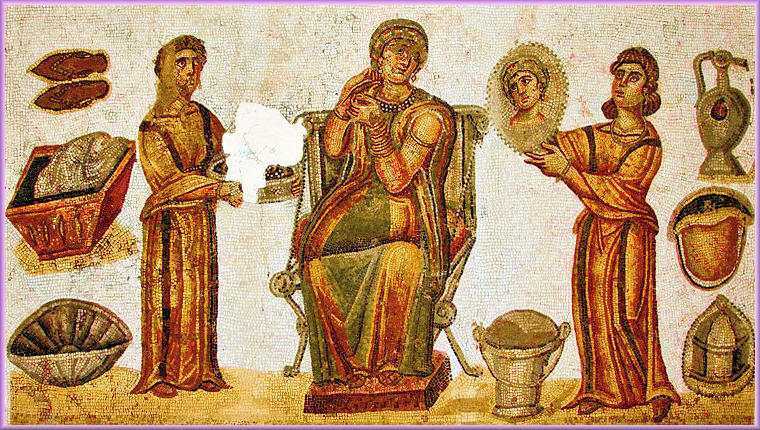
A mosaic of a Roman noblewoman at her morning toilet, aided by her maids and
slaves. Whilst not of Sabina
it gives an indication of a daily life
that involved elaborate and time-consuming preparation of her appearance
and
dress before even greeting her husband - let alone appearing in public.
Nero appeared to be devoted to his new wife. She accompanied him
everywhere in Athens and later Rome, and he was often seen fondling
and kissing her whilst they were being carried around the cities in a litter.
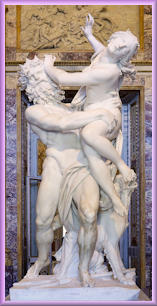
A depiction of the Rape of Persephone |
Whilst Nero might have actually been in love with Sporus/Sabina,
her life nevertheless probably depended upon successfully playing the role
of his wife and the Empress. We have only one, but
very telling,
hint in
the sources as to her own feelings. To mark the start of the New Year,
on 1 January AD68 she gave to the Emperor a ring depicting the Rape of
Persephone - a mythical girl who was kidnapped by Hades and taken into the
underworld to become his bride against her will.
The End
Although the Greeks and Athenians lauded the emperor as became a rich benefactor,
his attempts as an actor met with little success.
When the disappointed Nero returned from Greece to Rome in early AD 68, it seems that he was
unaware of just how unpopular he had become, whilst Sabina's background was now well known.
Every previous Empress had been publicly presented - with at least some
credibility - as the perfect
wife and mother. Sabina was
obviously
infertile and Suetonius records:
"A rather amusing joke is still going the rounds - the
world would have been a happier place had Nero's father Domitius married
that sort of wife."
Sulpicius Galba, the governor-general of Spain was encouraged by Marcus Otho
(Poppaea's ex-husband) to lead a revolt against Nero. The Praetorian Guard prefect Nymphidius Sabinus
then persuaded his soldiers to
also desert Nero and the end came in early June AD 68
when Nero awoke in his palace to find
that the palace guard and his attendants had all left. With just four
loyal companions remaining - interestingly including Sabina but not Statilia
- he fled to a small villa outside Rome.
The Roman Senate named
Galba the new emperor on 8 June and
declared Nero to be a public enemy. With arrest imminent, Nero committed suicide on
9 June, comforted by Sabina in his final lamentations. Nero
allegedly asked Sabina to set him an example by committing suicide
first - but she managed to escape this fate.

A
fresco from a house in Pompeii, painted before the AD79 earthquake. Archaeologists
uncertainly name the central figure as being
Venus (or maybe Aphrodite), with Mars. An alternative
interpretation is that
it's a subtle lampooning of Sporus / Sabina and Nero. The woman's face and hair style, large frame,
slight bust and carefully hidden genitalia provide support for this
theory. |
The Senate officially condemned Nero’s memory - and all statues and
portraiture of Poppaea Sabina were to be destroyed along with those of Nero.
Encore
The life of the still only 18 year-old Sabina
became even more extra-ordinary after the death Nero. She seems to have
accepted her life as a woman called
Poppaea Sabina, and there are no hints in historical sources
that she/he sought to
change this after Nero's death. As an ex-empress she was a very valuable prize
to many important men, whilst the probable alternative of insisting that she was
actually a male
slave would have been easy to dismiss!
The first important man to claim Sabina (although he preferred to call her Poppaea) after
the death of Nera was Nymphidius Sabinus. He had apparently long been fascinated
with her, and seized her whilst Nero's body still burned on a pyre.
Although age 68, in quick succession he took her as his mistress and then wife.
Sabinus aspired to become emperor
and declared that he was a legitimate successor to Nero — a claim which he
supported with the dubious assertion that he was the illegitimate son of the
former emperor Caligula, plus his new marriage to the former Empress. But
the Praetorian Guard was not convinced that he could beat
Galba whose army was now approaching Rome - likely resulting in their own
deaths - and killed him before Galba finally arrived in October.
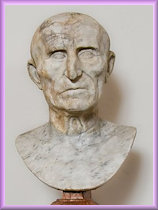
A bust of
Servius Galba Caesar Augustus (1 BC - 68 AD) |
Galba was already renowned for his avarice, and he quickly proved to be a sickly and uninspiring leader
who gained no affection from the population of Rome. The new emperor
was soon in serious trouble when the army turned against him when he failed to pay the soldiers a
promised generous donative. Also, Marcus Otho was dismayed that he had not been named Galba's
successor and Suetonius wrote, “Disappointment, resentment and
a massive accumulation of debt now prompted him to revolt." With the support
and assistance of the Praetorian Guard, Otho masterminded Galba's
assassination on 15 January, AD 69, and was proclaimed the new emperor.
Otho made a good start as one of his first acts as emperor was to appear before the
Senate where he promised to “respect the people's sovereign will.” He
reinstituted gladiatorial games (which had been banned by Nero), rewarded
the officials and soldiers who had helped him overthrow Galba, and restored
the fallen statures of Nero and Poppaea.
Most sources (both ancient and modern) assume that Otho's wife - Poppaea
Sabina - was the same woman that he had married ten years earlier.
This lazy assumption is perhaps understandable given that Otho was a minor
and short-lived Emperor, plus there was a lot of potential for confusion.
However it was incorrect. Upon his arrival in Rome, Otho - now age 65
- had taken in the again newly widowed Sabina (aka Sporus) and despite the huge age
difference treated her as being
his former wife of the same name, and "had intimacy with Sporus”. Whilst ancient sources fail to
describe any wedding ceremony, Otho left no one in doubt that Sabina was his wife, and
later the
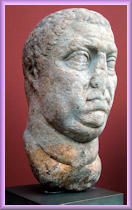
A bust of Vitellius,
(15-69 AD) |
Empress.
Sabina would enjoy being Empress again for only three months.
A new usurper had emerged - Aulus
Vitellius - who been appointed by Galba as the governor-general of Lower Germany only a few months earlier. Otho tried to reach a settlement with him, but instead Vitellius marched on
Rome. On 14 April AD 69
the rival armies fought the Battle of Bedriacum; after bitter and bloody
combat Otho's army lost and two days later he committed suicide.
Vitellius continued his march on Rome, where he made a triumphal entry and
was recognized as emperor by the Senate on 19 April.
The End
 Vitellius claimed all the possessions of the former emperor, which
included Sabina.
By this time Sabina was universally accepted as a
legitimate former wife of Nero, and a twice Empress - including by Vitellius who
needed to maximise the importance of his trophy. But unfortunately for Sabina the latest emperor was not looking for a wife who would help cement his position, but rather for a way to emphasise
his power. Vitellius claimed all the possessions of the former emperor, which
included Sabina.
By this time Sabina was universally accepted as a
legitimate former wife of Nero, and a twice Empress - including by Vitellius who
needed to maximise the importance of his trophy. But unfortunately for Sabina the latest emperor was not looking for a wife who would help cement his position, but rather for a way to emphasise
his power.
Vitellius
decided to hold gladiatorial games to
endear himself to the population of Rome. He or one of his
courtiers must have recollected Sabina's infamous gift of a ring to Nero
so he decided that the highlight of the games would be a re-enactment of the
Rape of Persephone, with Sabina playing the role of
the maiden being ravished - with a brutal death very likely. Upon
learning of her planned fate, Sabina committed suicide by unknown means, age just 19 or at
the most 20.
Vitellius quickly became notorious for his cruelty, gluttony, and huge unpaid gambling
debts - and in turn would be dethroned, tortured and killed in December AD 69.
Comment
Sporus must have been an extraordinary person with a gift for enchanting
men and satisfying them sexually. Despite being physically a male eunuch, she was accepted as being a reborn
"Poppaea Sabina" by her former husbands (both emperors) and another
important official. None seem to have regretted their decision to
marry Sabina/Sporus, brief though these marriages were.
Paintings
The story of Poppaea Sabina and Sporus has attracted the
interest of many artists. A few examples are shown below.

Poppaea Brings the Head of Octavia to Nero, by Giovanni
Muzzioli (1876)
|

Poppaea Sabina, by William Henry Longmaid
(1887)
|

Poppaea Sabina, unknown painter, perhaps French (c.1570-80)
|



Poppeae Sabina was a favourite historical subject of the English artist
John William Godward (1861-1922), who painted many pictures of her. |
Film:

The
minor Italian film Fellini Satyricon (1969)
is set in the Rome of Nero.
The bizarre and surreal adventures of
the lead character, a teenage Romanian
boy called Encolpio who
sold himself as a woman, "even when he'd be[en]
approached as a man",
are surely inspired by Sporus.
Original Sources:
 Modern Sources: Modern Sources:
Historical Fiction:
-
Delicatus: from slave to empress in imperial Rome, S.P. Somtow,
2023
-
Sporus, Maryanne Peters, 2018
-
The Four Emperors, David Blixt, 2021
|





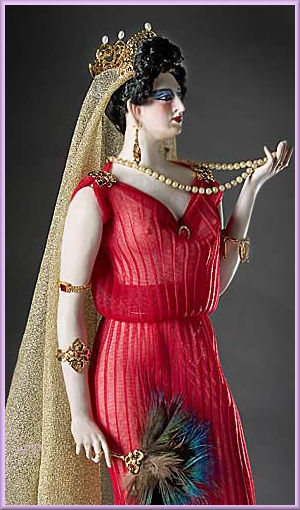


























 Back to Articles
Back to Articles (No spaces)
(No spaces)